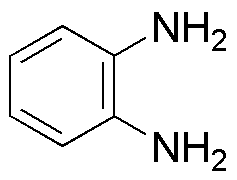o-Phenylenediamine is widely utilized in research focused on:
- Dyes and Pigments: This compound is a key ingredient in the production of azo dyes, which are used in textiles, inks, and food coloring due to their vibrant colors and stability.
- Analytical Chemistry: It serves as a reagent in various chemical analyses, particularly in the detection of certain metals and as a colorimetric indicator, making it valuable in laboratories.
- Polymer Industry: o-Phenylenediamine is used as a curing agent in the production of polyurethane and epoxy resins, enhancing the durability and performance of materials in construction and automotive applications.
- Pharmaceuticals: It plays a role in the synthesis of various pharmaceutical compounds, contributing to the development of medications that target a range of health conditions.
- Electrochemical Applications: This chemical is utilized in the fabrication of sensors and electrodes, particularly in biosensors, due to its electroactive properties, which improve sensitivity and performance.
General Information
Properties
Safety and Regulations
Applications
o-Phenylenediamine is widely utilized in research focused on:
- Dyes and Pigments: This compound is a key ingredient in the production of azo dyes, which are used in textiles, inks, and food coloring due to their vibrant colors and stability.
- Analytical Chemistry: It serves as a reagent in various chemical analyses, particularly in the detection of certain metals and as a colorimetric indicator, making it valuable in laboratories.
- Polymer Industry: o-Phenylenediamine is used as a curing agent in the production of polyurethane and epoxy resins, enhancing the durability and performance of materials in construction and automotive applications.
- Pharmaceuticals: It plays a role in the synthesis of various pharmaceutical compounds, contributing to the development of medications that target a range of health conditions.
- Electrochemical Applications: This chemical is utilized in the fabrication of sensors and electrodes, particularly in biosensors, due to its electroactive properties, which improve sensitivity and performance.
Documents
Safety Data Sheets (SDS)
The SDS provides comprehensive safety information on handling, storage, and disposal of the product.
Product Specification (PS)
The PS provides a comprehensive breakdown of the product’s properties, including chemical composition, physical state, purity, and storage requirements. It also details acceptable quality ranges and the product's intended applications.
Certificates of Analysis (COA)
Search for Certificates of Analysis (COA) by entering the products Lot Number. Lot and Batch Numbers can be found on a product’s label following the words ‘Lot’ or ‘Batch’.
*Catalog Number
*Lot Number
Certificates Of Origin (COO)
This COO confirms the country where the product was manufactured, and also details the materials and components used in it and whether it is derived from natural, synthetic, or other specific sources. This certificate may be required for customs, trade, and regulatory compliance.
*Catalog Number
*Lot Number
Safety Data Sheets (SDS)
The SDS provides comprehensive safety information on handling, storage, and disposal of the product.
DownloadProduct Specification (PS)
The PS provides a comprehensive breakdown of the product’s properties, including chemical composition, physical state, purity, and storage requirements. It also details acceptable quality ranges and the product's intended applications.
DownloadCertificates of Analysis (COA)
Search for Certificates of Analysis (COA) by entering the products Lot Number. Lot and Batch Numbers can be found on a product’s label following the words ‘Lot’ or ‘Batch’.
*Catalog Number
*Lot Number
Certificates Of Origin (COO)
This COO confirms the country where the product was manufactured, and also details the materials and components used in it and whether it is derived from natural, synthetic, or other specific sources. This certificate may be required for customs, trade, and regulatory compliance.


